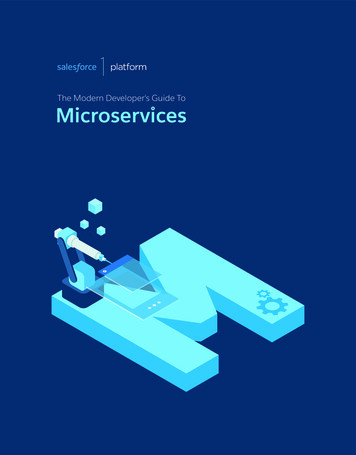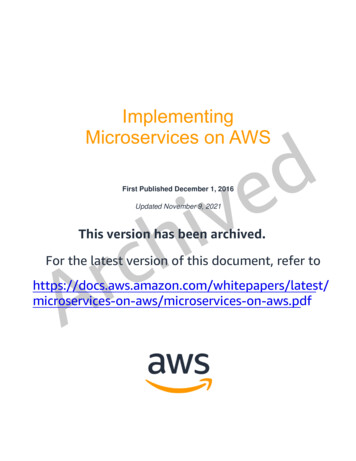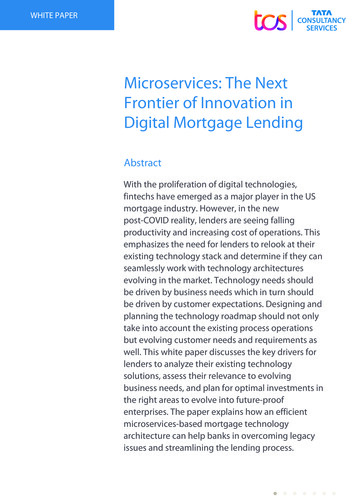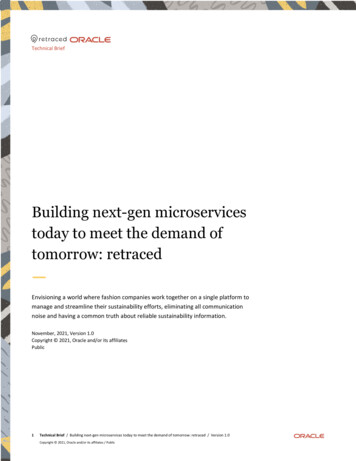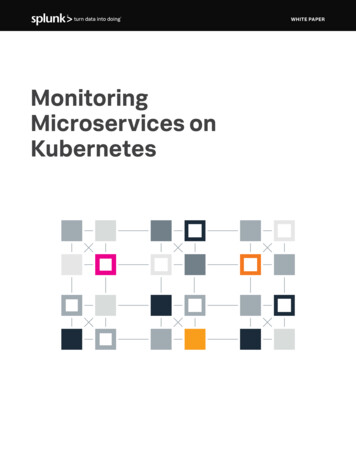
Transcription
Microservices AntiPatternsand PitfallsMark RichardsBeijingBoston Farnham SebastopolTokyo
Microservices Antipatterns and Pitfallsby Mark RichardsCopyright 2016 O’Reilly Media, Inc. All rights reserved.Printed in the United States of America.Published by O’Reilly Media, Inc., 1005 Gravenstein Highway North, Sebastopol, CA95472.O’Reilly books may be purchased for educational, business, or sales promotional use.Online editions are also available for most titles (http://safaribooksonline.com). Formore information, contact our corporate/institutional sales department:800-998-9938 or corporate@oreilly.com.Editor: Brian FosterProduction Editor: Melanie YarbroughCopyeditor: Christina EdwardsProofreader: Amanda KerseyJuly 2016:Interior Designer: David FutatoCover Designer: Karen MontgomeryIllustrator: Rebecca DemarestFirst EditionRevision History for the First Edition2016-07-06: First ReleaseThe O’Reilly logo is a registered trademark of O’Reilly Media, Inc. MicroservicesAntiPatterns and Pitfalls, the cover image, and related trade dress are trademarks ofO’Reilly Media, Inc.While the publisher and the author have used good faith efforts to ensure that theinformation and instructions contained in this work are accurate, the publisher andthe author disclaim all responsibility for errors or omissions, including without limi‐tation responsibility for damages resulting from the use of or reliance on this work.Use of the information and instructions contained in this work is at your own risk. Ifany code samples or other technology this work contains or describes is subject toopen source licenses or the intellectual property rights of others, it is your responsi‐bility to ensure that your use thereof complies with such licenses and/or rights.978-1-491-96331-9[LSI]
Table of ContentsPreface. . . . . . . . . . . . . . . . . . . . . . . . . . . . . . . . . . . . . . . . . . . . . . . . . . . . . . . . v1. Data-Driven Migration AntiPattern. . . . . . . . . . . . . . . . . . . . . . . . . . . . 1Too Many Data MigrationsFunctionality First, Data Last242. The Timeout AntiPattern. . . . . . . . . . . . . . . . . . . . . . . . . . . . . . . . . . . . . 7Using Timeout ValuesUsing the Circuit Breaker Pattern893. The “I Was Taught to Share” AntiPattern. . . . . . . . . . . . . . . . . . . . . . . 13Too Many DependenciesTechniques for Sharing Code14154. Reach-in Reporting AntiPattern. . . . . . . . . . . . . . . . . . . . . . . . . . . . . . 19Issues with Microservices ReportingAsynchronous Event Pushing19225. Grains of Sand Pitfall. . . . . . . . . . . . . . . . . . . . . . . . . . . . . . . . . . . . . . . . 25Analyzing Service Scope and FunctionAnalyzing Database TransactionsAnalyzing Service Choreography2628296. Developer Without a Cause Pitfall. . . . . . . . . . . . . . . . . . . . . . . . . . . . 33Making the Wrong DecisionsUnderstanding Business Drivers3335iii
7. Jump on the Bandwagon Pitfall. . . . . . . . . . . . . . . . . . . . . . . . . . . . . . 37Advantages and DisadvantagesMatching Business NeedsOther Architecture Patterns3740418. The Static Contract Pitfall. . . . . . . . . . . . . . . . . . . . . . . . . . . . . . . . . . . . 43Changing a ContractHeader VersioningSchema Versioning4445469. Are We There Yet Pitfall. . . . . . . . . . . . . . . . . . . . . . . . . . . . . . . . . . . . . 49Measuring LatencyComparing Protocols495010. Give It a Rest Pitfall. . . . . . . . . . . . . . . . . . . . . . . . . . . . . . . . . . . . . . . . . 51Asynchronous RequestsBroadcast CapabilitiesTransacted Requestsiv Table of Contents525354
PrefaceIn late 2006 service-oriented architecture (SOA) was all the craze.Companies were jumping on the bandwagon and embracing SOAbefore fully understanding the advantages and disadvantages of thisvery complex architecture style. Those companies that embarked onSOA projects often found constant struggles with service granular‐ity, performance, data migrations, and in particular the organiza‐tional change that comes about with SOA. As a result, manycompanies either abandoned their SOA efforts or built hybrid archi‐tectures that did not fulfill all of the promises of SOA.Today we are poised to repeat this same experience with a relativelynew architecture style known as microservices. Microservices is acurrent trend in the industry right now, and like SOA back in themid 2000s, is all the craze. As a result, many companies are lookingtoward this architecture style to leverage the benefits provided bymicroservices such as ease of testing, fast and easy deployments,fine-grained scalability, modularity, and overall agility. However, likeSOA, companies developing microservices are finding themselvesstruggling with things like service granularity, data migration,organizational change, and distributed processing challenges.As with any new technology, architecture style, or practice, antipat‐terns, and pitfalls usually emerge as you learn more about it andexperience the many “lessons learned” during the process. Whileantipatterns and pitfalls may seem like the same thing, there is asubtle difference between them. Andrew Koenig defines an antipat‐tern as something that seems like a good idea when you begin, butleads you into trouble, whereas my friend Neal Ford defines a pitfallas something that was never a good idea, even from the start. This isv
an important distinction because you may not experience the nega‐tive results from an antipattern until you are well into the develop‐ment lifecycle or even well into production, whereas with a pitfallyou usually find out you are headed down the wrong path relativelyquickly.This report will introduce several of the more common antipatternsand pitfalls that emerge when using microservices. My goal with thisreport is to help you avoid costly mistakes by not only helping youunderstand when an antipattern or pitfall is occurring, but moreimportantly helping you understand the techniques and practicesfor avoiding these antipatterns and pitfalls.While I don’t have time in this report to cover the details of all of thevarious antipatterns and pitfalls you might encounter with micro‐services, I do cover some of the more common ones. These includeantipatterns and pitfalls related to service granularity (Chapter 5,Grains of Sand Pitfall), data migration (Chapter 1, Data-DrivenMigration AntiPattern), remote access latency (Chapter 9, Are WeThere Yet Pitfall), reporting (Chapter 4, Reach-in Reporting AntiPat‐tern), contract versioning (Chapter 8, The Static Contract Pitfall),service responsiveness (Chapter 2, The Timeout AntiPattern), andmany others.I recently recorded a video for O’Reilly called Microservices AntiPat‐terns and Pitfalls: Learning to Avoid Costly Mistakes that contains thecomplete set of antipatterns and pitfalls you may encounter whenusing microservices, as well as a more in-depth look into each one.Included in the video is a self-assessment workbook containinganalysis tasks and goals oriented around analyzing your currentapplication. You can use this assessment workbook to determinewhether you are experiencing any of the antipatterns and pitfallsintroduced in the video and ways to avoid them.Conventions Used in This BookThe following typographical conventions are used in this book:ItalicIndicates new terms, URLs, email addresses, filenames, and fileextensions.vi Preface
Constant widthUsed for program listings, as well as within paragraphs to referto program elements such as variable or function names, data‐bases, data types, environment variables, statements, and key‐words.Constant width boldShows commands or other text that should be typed literally bythe user.Constant width italicShows text that should be replaced with user-supplied values orby values determined by context.Safari Books OnlineSafari Books Online is an on-demand digitallibrary that delivers expert content in bothbook and video form from the world’s lead‐ing authors in technology and business.Technology professionals, software developers, web designers, andbusiness and creative professionals use Safari Books Online as theirprimary resource for research, problem solving, learning, and certif‐ication training.Safari Books Online offers a range of plans and pricing for enter‐prise, government, education, and individuals.Members have access to thousands of books, training videos, andprepublication manuscripts in one fully searchable database frompublishers like O’Reilly Media, Prentice Hall Professional, AddisonWesley Professional, Microsoft Press, Sams, Que, Peachpit Press,Focal Press, Cisco Press, John Wiley & Sons, Syngress, MorganKaufmann, IBM Redbooks, Packt, Adobe Press, FT Press, Apress,Manning, New Riders, McGraw-Hill, Jones & Bartlett, Course Tech‐nology, and hundreds more. For more information about SafariBooks Online, please visit us online.Preface vii
How to Contact UsPlease address comments and questions concerning this book to thepublisher:O’Reilly Media, Inc.1005 Gravenstein Highway NorthSebastopol, CA 95472800-998-9938 (in the United States or Canada)707-829-0515 (international or local)707-829-0104 (fax)To comment or ask technical questions about this book, send emailto bookquestions@oreilly.com.For more information about our books, courses, conferences, andnews, see our website at http://www.oreilly.com.Find us on Facebook: http://facebook.com/oreillyFollow us on Twitter: http://twitter.com/oreillymediaWatch us on YouTube: I would like to acknowledge several people who helped make thisreport a success. First, I would like to thank Matt Stine for the tech‐nical review of the report. His technical knowledge and expertise inmicroservices helped to not only validate the various technicalaspects of the report, but also to enhance certain chapters with addi‐tional insight and material. Next, I would like to thank my friendand partner-in-crime Neal Ford for helping me understand the dif‐ferences between pitfalls and antipatterns and for also helping meproperly classify each of the antipatterns and pitfalls I wrote aboutin this report. I would also like to thank the editorial staff at O’Reillyfor their help in making the authoring process as easy and painlessas possible. Finally, I would like to thank my wife and kids forputting up with me on yet another project (albeit small) that takesme away from what I like doing most—being with my family.viii Preface
CHAPTER 1Data-Driven Migration AntiPatternMicroservices is about creating lots of small, distributed singlepurpose services, with each service owning its own data. This ser‐vice and data coupling supports the notion of a bounded contextand a share-nothing architecture, where each service and its corre‐sponding data are compartmentalized and completely independentfrom all other services, exposing only a well-defined interface (thecontract). This bounded context is what allows for quick and easydevelopment, testing, and deployment with minimal dependencies.The data-driven migration antipattern occurs mostly when you aremigrating from a monolithic application to a microservices architec‐ture. The reason this is an antipattern is that it seems like a goodidea at the start to migrate both the service functionality and thecorresponding data together when creating microservices, but asyou will learn in this chapter, this will lead you down a bad path thatcan result in high risk, excess cost, and additional migration effort.There are two primary goals during any microservices conversioneffort. The first goal is to split the functionality of the monolithicapplication into small, single-purpose services. The second goal is tothen migrate the monolithic data into small databases (or separateschemas) owned by each service. Figure 1-1 shows what a typicalmigration might look like when both the service code and the corre‐sponding data are migrated at the same time.1
Figure 1-1. Service and data migrationNotice there are three services created from the monolithic applica‐tion along with three separate databases. This is a natural migrationprocess because you are creating that critical bounded contextbetween each service and its corresponding data. However, prob‐lems start to arise with this common practice, thus leading you intothe data-driven migration antipattern.Too Many Data MigrationsThe main problem with this type of migration path is that you willrarely get the granularity of each service right the first time. Know‐ing it is always a good idea to start with a more coarse-grained ser‐vice and split it up further if needed when you learn more about theservice, you may be frequently adjusting the granularity of yourservices. Consider the migration illustrated in Figure 1-1, focusingon the leftmost service. Let’s say after learning more about the ser‐vice you discover it’s too coarse-grained and needs to be split up intotwo smaller services. Alternatively, you may find that the two left‐most services are too fine-grained and need to be consolidated. Ineither case you are faced with two migration efforts—one for theservice functionality and another for the database. This scenario isillustrated in Figure 1-2.2 Chapter 1: Data-Driven Migration AntiPattern
Figure 1-2. Extra data migration after service granularity adjustmentMy good friend and fellow O’Reilly author Alan Beaulieu (LearningSQL) once told me “Data is a corporate asset, not an applicationasset.” Given Alan’s statement, you can gain an appreciation for therisk involved and the concerns raised with continually migratingdata. Data migrations are complex and error-prone—much more soToo Many Data Migrations 3
than source code migrations. Optimally you want to migrate thedata for each service only once. Understanding the risks involvedwith data migration and the importance of “data over functionality”is the first step in avoiding this antipattern.Functionality First, Data LastThe primary avoidance technique for this antipattern is to migratethe functionality of the service first, and worry about the boundedcontext between the service and the data later. Once you learn moreabout the service you will likely find the need to adjust the level ofgranularity through service consolidation or service splitting. Afteryou are satisfied that you have the level of granularity correct, thenmigrate the data, thereby creating the much-needed bounded con‐text between the service and the data.This technique is illustrated in Figure 1-3. Notice how all three serv‐ices have been migrated, but are still connecting to the monolithicdata. This is perfectly fine for an interim solution, because now youcan learn more about how the service is used and what type ofrequests will be handled by each service.4 Chapter 1: Data-Driven Migration AntiPattern
Figure 1-3. Migrate service functionality first, then data portion laterFunctionality First, Data Last 5
In Figure 1-3, notice how the service was found to be too coarsegrained and was consequently split into two smaller services. Nowthat the granularity is correct, the data can be migrated to create thebounded context between the service and the corresponding data.This technique avoids costly and repeated data migrations andmakes it easier to adjust the service granularity when needed. Whileit is impossible to say how long to wait before migrating the data, itis important to understand the consequences of this avoidance tech‐nique—a poor bounded context. The time between when the serviceis created and the data is finally migrated creates a data couplingbetween services. This means that when the database schema ischanged, all services using that schema must be coordinated from achange control and release standpoint, something you want to avoidwith the microservices architecture. However, this tradeoff is wellworth the reduced risk involved with avoiding multiple costly data‐base migrations.6 Chapter 1: Data-Driven Migration AntiPattern
CHAPTER 2The Timeout AntiPatternMicroservices is a distributed architecture, meaning all of the com‐ponents (i.e., services) are deployed as separate applications and areaccessed remotely through some sort of remote access protocol. Oneof the challenges of any distributed architecture is managing remoteprocess availability and responsiveness. Although service availabilityand service responsiveness are both related to service communica‐tion, they are two very different things. Service availability is theability of the service consumer to connect with the service and beable to send it a request, as shown in Figure 2-1. Service responsive‐ness, on the other hand, is the time it takes for the service torespond to a given request once you’ve communicated with it.Figure 2-1. Service availability vs. responsivenessIf the service consumer cannot connect with or talk to the service(i.e., availability), the service consumer is usually immediately noti‐fied within milliseconds, as Figure 2-1 shows. The service consumermay choose to pass this error onto the client or retry the connectionseveral times before giving up and throwing some sort of connec‐tion failure. However, assuming the service was reached and a7
request was made, what happens if the service doesn’t respond? Inthis case the service consumer can choose to wait indefinitely or lev‐erage some sort of timeout value.Using a timeout value for service responsiveness seems like a goodidea, but can lead you down a bad path known as the timeout antipattern.Using Timeout ValuesYou might be a bit confused at this point. After all, isn’t setting atimeout value a good thing? Maybe, but in most cases it can lead youdown a bad path. Consider the example where you are making a ser‐vice request to buy 1000 shares of Apple stock (AAPL). The very lastthing you want to do as the service consumer is time out the requestright when the service has successfully placed the trade and is aboutto give you a confirmation number. You can try to resubmit thetrade, but you have to add significant complexity into your serviceto determine if this is a new trade or a duplicate trade. Furthermore,since you don’t have a confirmation number from the first trade it isvery difficult to know whether the trade was actually successful ornot.So, given that you don’t want to time out the request too early, whatshould the timeout value be? There are several techniques to addressthis problem. The first is to calculate the database timeout withinthe service and use that as a base for determining what the servicetimeout should be. The second solution, which is by far the mostpopular technique, is to calculate the maximum time under load anddouble it, thereby giving you that extra buffer in the event it some‐times takes longer.Figure 2-2 illustrates this technique. Notice that on average the ser‐vice responds within 2 seconds to place a trade. However, underload the maximum time observed is 5 seconds. Therefore, using thedoubling technique, the timeout value for the service consumerwould be 10 seconds. Again, the intention with this technique is toavoid timing out the request when in fact it was successful and wasin the process of sending you back the confirmation number.8 Chapter 2: The Timeout AntiPattern
Figure 2-2. Calculating a timeout valueIt should be clear now why this approach is an antipattern. Whilethis seems like a perfectly logical solution to the timeout problem, itcauses every request from service consumers to have to wait 10 sec‐onds just to find out the service is not responsive. Ten seconds is along time to wait for an error. In most cases users won’t wait morethan 2 to 3 seconds before hitting the submit button again or givingup and closing the screen. There must be a better way to deal withserver responsiveness.Using the Circuit Breaker PatternRather than relying on timeout values for your remote service calls,a better approach is to use something called the circuit breaker pat‐tern. This software pattern works just like a circuit breaker in yourhouse. When it is closed, electricity flows through it, but once it isopen, no electricity can pass until the breaker is closed. Similarly, if asoftware circuit breaker detects that a service is not responding, itwill open, rejecting requests to that service. Once the servicebecomes responsive, the breaker will close, allowing requeststhrough.Figure 2-3 illustrates how the circuit breaker pattern works. The cir‐cuit breaker continually monitors the remote service, ensuring thatit is alive and responsive (more on that part later). While the serviceremains responsive the breaker will be closed, allowing requeststhrough. If the remote service suddenly becomes unresponsive, thecircuit breaker opens, thus preventing requests from going throughuntil the service once again becomes responsive. However, unlikethe circuit breaker in your house, a software circuit breaker can con‐tinue monitoring the service and close itself once the remote servicebecomes responsive again.Using the Circuit Breaker Pattern 9
Figure 2-3. Circuit breaker patternDepending on the implementation, the service consumer will alwayscheck with the circuit breaker first to see if it is open or closed. Thiscan also be done through an interceptor pattern so the service con‐sumer doesn’t need to know the circuit breaker is in the requestpath. In either case, the significant advantage of the circuit breakerpattern over timeout values is that the service consumer knows rightaway that the service has become unresponsive rather than having towait for the timeout value. In the prior example, if a circuit breakerwas used instead of the timeout value, the service consumer wouldknow within milliseconds that the trade-placement service was notresponsive rather than having to wait 10 seconds (10,000 milli‐seconds) to get the same information.Circuit breakers can monitor the remote service in several ways. Thesimplest way is to do a simple heartbeat check on the remote service(e.g., ping). While this is relatively easy and inexpensive, all it does istell the circuit breaker that the remote service is alive, but says noth‐ing as to the responsiveness of the actual service request. To get bet‐ter information about the responsiveness of the request you can usesynthetic transactions. A synthetic transaction is another monitor‐ing technique circuit breakers can use where a fake transaction isperiodically sent to the service (e.g., once every 10 seconds). Thefake transaction performs all of the functionality required withinthat service, allowing the circuit breaker to gain an accurate measureof responsiveness. Synthetic transactions can be very tricky and dif‐ficult to implement in that all parts of the application or system needto know about the synthetic transaction. A third type of monitoringis real-time user monitoring, where actual production transactionsare monitored for responsiveness. Once a threshold is reached, thebreaker moves into what is called a half-open state, where only acertain number of transactions are let through (say 1 out of 10).10 Chapter 2: The Timeout AntiPattern
Once the service responsiveness goes back to normal, the breaker isthen closed, allowing all transactions through.There are several open source implementations of the circuitbreaker pattern, including Hystrix from Netflix and a plethora ofGitHub implementations. The Akka framework includes a circuitbreaker implementation as part of the framework implementedthrough the Akka CircuitBreaker class.You can get more information about the circuit breaker patternthrough the following resources: Michael Nygard’s excellent book Release It! Martin Fowler’s circuit breaker blog post Microsoft MSDN libraryUsing the Circuit Breaker Pattern 11
CHAPTER 3The “I Was Taught to Share”AntiPatternMicroservices is known as a “share-nothing” architecture. Pragmati‐cally, I prefer to think of it as a “share-as-little-as-possible” architec‐ture because there will always be some level of code that is sharedbetween microservices. For example, rather than having a securityservice that is responsible for authentication and authorization, youmight have the source code and security functionality wrapped in aJAR file named security.jar that all services use. Assuming security ishandled at the services level, this is generally a good practice becauseit eliminates the need to make a remote call to a security service forevery request, thereby increasing both performance and reliability.However, taken too far, you end up with a dependency nightmare asillustrated in Figure 3-1, where every service is dependent on multi‐ple custom shared libraries.13
Figure 3-1. Sharing multiple custom librariesThis level of sharing not only breaks down the bounded context ofeach service, but also introduces several issues, including overallreliability, change control, testability, and deployment.Too Many DependenciesIf you consider how most object-oriented software applications aredeveloped, it’s not hard to see the issues with sharing, particularlywhen migrating from a monolithic layered architecture to a micro‐services one. One of the things to strive for in most monolithicapplications is code reuse and sharing. Figure 3-2 illustrates the twomain artifacts (abstract classes and shared utilities) that end upbeing shared in most monolithic layered architectures.14 Chapter 3: The “I Was Taught to Share” AntiPattern
Figure 3-2. Sharing inheritance structures and utility classesWhile creating abstract classes and interfaces is a common practicewith most object-oriented programming languages, they get in theway when trying to migrate modules to a microservices architecture.The same goes with custom shared classes and utilities such as com‐mon date or string utilities and calculation utilities. What do you dowith the code that needs to be shared by potentially hundreds ofservices?One of the primary goals of the microservices architecture style is toshare as little as possible. This helps preserve the bounded context ofeach service, which is what gives you the ability to do quick testingand deployment. With microservices it all boils down to changecontrol and dependencies. The more dependencies you havebetween services, the harder it is to isolate service changes, makingit difficult to separately test and deploy individual services. Sharingtoo much creates too many dependencies between services, resultingin brittle systems that are very difficult to test and deploy.Techniques for Sharing CodeIt’s easy to say the best way to avoid this antipattern is simply not toshare code between services. But, as I stated at the start of this chap‐ter, pragmatically there will always be some code that needs to beshared. Where should that shared code go?Techniques for Sharing Code 15
Figure 3-3 illustrates the four basic techniques for addressing theproblem of code sharing: shared projects, shared libraries, replica‐tion, and service consolidation.Figure 3-3. Module-sharing techniquesUsing a shared project forms a compile-time binding between com‐mon source code that is located in a shared project and each serviceproject. While this makes it easy to change and develop software, itis my least favorite sharing technique because it causes potentialissues and surprises during runtime, making applications lessrobust. The main issue with the shared project technique is that of16 Chapter 3: The “I Was Taught to Share” AntiPattern
communication and control—it is difficult to know what sharedmodules changed and why, and also hard to control whether youwant that particular change or not. Imagine being ready to releaseyour microservice just to find out someone made a breaking changeto a shared module, requiring you to change and retest your codeprior to deployment.A better approach if you have to share code is to use a shared library(e.g., .NET assembly or JAR file). This approach makes developmentmore difficult because for each change made to a module in a sharedlibrary, the developer must first create the library, then restart theservice, and then retest. However, the advantage of the sharedlibrary technique is that libraries can be versioned, providing bettercontrol over the deployment and runtime behavior of a service. If achange is made to a shared library and versioned, the service ownercan make decisions about when to incorporate that change.A third technique that is common in a microservices architecture isto violate the don’t-repeat-yourself (DRY) principle and replicate theshared module across all services needing that particular functional‐ity. While the replication technique may seem risky, it avoidsdependency sharing and preserves the bounded context of a service.Problems arise with this technique when the replicated moduleneeds to be changed, particularly for a defect. In this case all servicesneed to change. Therefore, this technique is only really useful forvery stable shared modules that have little or no change.A fourth technique that is sometimes possible is to use service con‐solidation. Let’s say two or three services are all sharing some com‐mon code, and those common modules frequently change. Since allof the services must be tested and deployed with the common mod‐ule change anyway, you might as well just consolidate the function‐ality into a single service, thereby removing the dependent library.One word of advice regarding shared libraries—avoid combining allof your shared code into a single shared library like common.jar.Using a common library makes it difficult to know whether youneed to incorporate the shared code and when. A better technique isto separate your shared libraries into ones that have context. Forexample, create context-based libraries like security.jar, persis‐tence.jar, dateutils.jar, and so on. This separates code that doesn’tchange often from code that changes frequently, making it easier toTechniques for Sharing Code 17
determine w
microservices such as ease of testing, fast and easy deployments, fine-grained scalability, modularity, and overall agility. However, like SOA, companies developing microservices are finding themselves struggling with things like service granularity, data migration, orga
